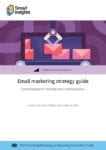The industry vibe is everyone gets too many emails, brands send too many emails and email marketers often see open rates in the 15% to 25% range
Why don’t more people unsubscribe from email? It’s a perplexing question.
The industry vibe is everyone gets too many emails, brands send too many emails and email marketers often see open rates in the 15% to 25% range.
Yet unsubscribe rates are typically around 0.25% - according to email industry benchmark reports.
Download our Premium Resource – Email marketing strategy guide
This comprehensive guide shows you how to take your email marketing strategy to the next level, covering a lot more than tips to improve your creative and copy.
Access the Email marketing strategy guide
The new "Email Addiction" consumer research report just published by Zettasphere and Emailmonday provides an answer.
The report is based on results of a consumer survey and sought to get the consumer view on several vexing questions about email marketing, including unsubscribe behaviour.
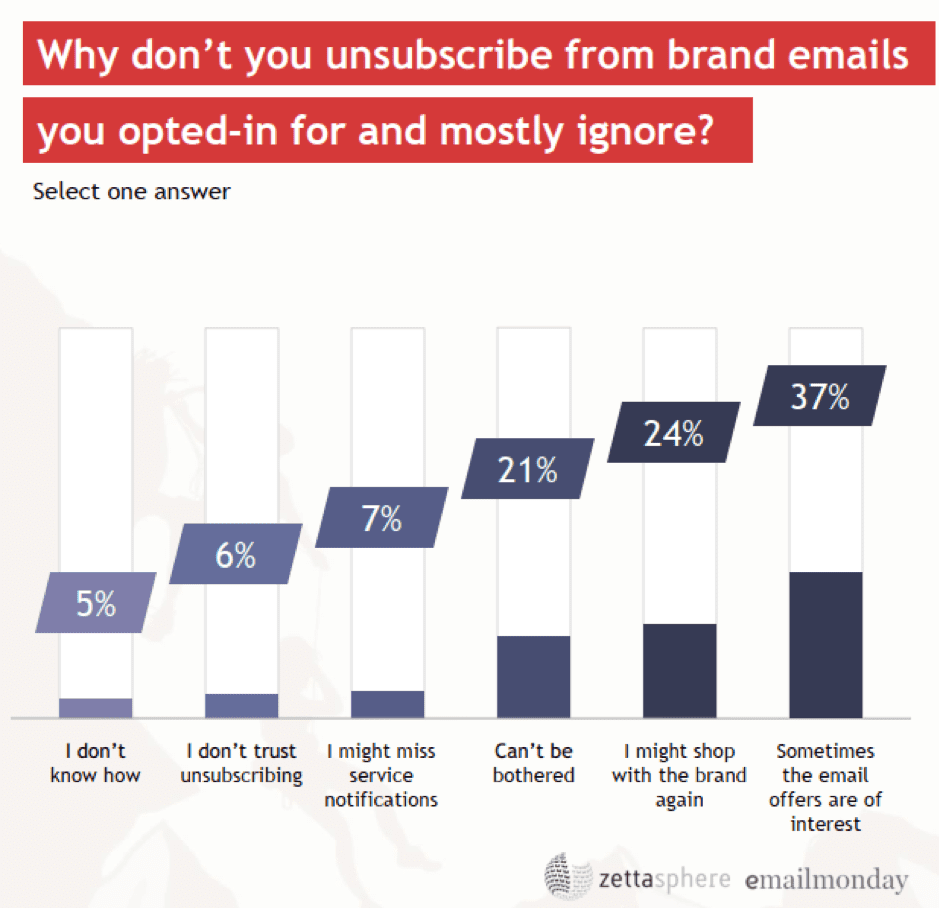
The good news is that in the majority of cases when you’re being ignored, consumers aren’t unsubscribing because they don’t want to hear from you at the moment - but do want to hear from you in the future. Being engaged in emails has a lot to do with being engaged in the brand. When you like the brand, you want the email – and you're happy to ignore a brand's email when you don’t need it.
In fact, a total of 61% of answers for not unsubscribing is because consumers have an expectation to shop with the brand again.
Conversely, taking together the responses of ‘I don’t know how’, ‘I don’t trust’ and ‘I can’t be bothered’, means a worrying 32% of people are a dead weight on your list.
A survey from Yes Lifecycle Marketing asked a related question; “Why consumer stay subscribed to retailer emails they don’t read”. The results echoed the Email Addiction research findings.
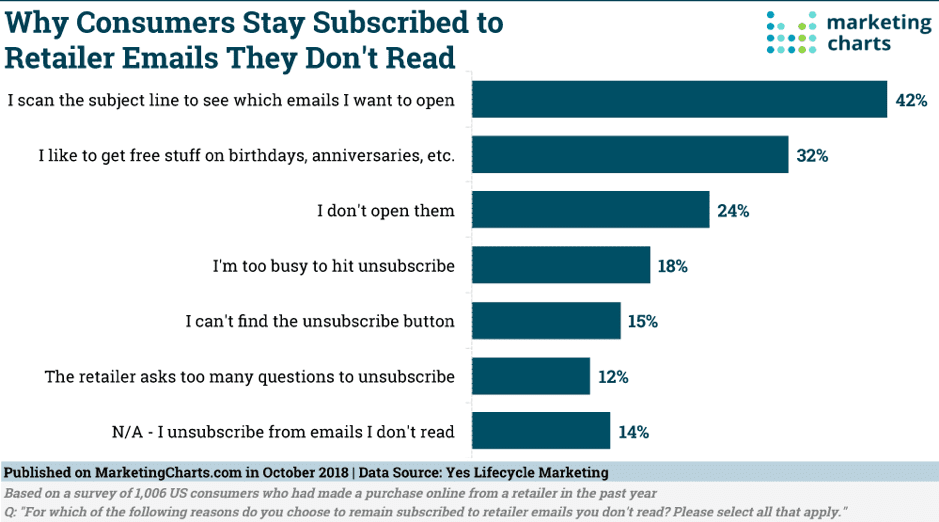
Two types of apparent inactive
It’s clear there are two main causes of not unsubscribing (but not reading) emails:
- Waiting for the right offer and the right moment – emotionally engaged.
- It’s too hard to unsubscribe and it’s easier to ignore the email – emotionally unsubscribed.
The second one of these damages delivery reputation.
Gmail is the most popular inbox provider with over 1.2 billion users. How Gmail filters email is important. Whilst all inbox providers have their own unique algorithms, the algorithms share the same concepts. A big part of which is looking at inbox behaviour for each email.
Gmail builds sender reputation from positive and negative signals - the things that readers do. Not only is moving an email to junk a negative signal but also deleting an email without opening. That’s the behaviour of the emotionally unsubscribed.
It’s not just a worry for B2C, it applies to B2B too. The trend is for businesses to use Office 365 and G-Suite services to host their employee’s inboxes.
I recently analyzed a large B2B database. Some 50% of the addresses that were business domains were using inboxes hosted using G-Suite or Office 365.
This means there is a good chance that even if recipients aren’t using addresses @gmail.com or @outlook.com, the method of spam filtering is still coming from Google and Microsoft.
When a sender has the signs of weak inbox placement, the quick fix to improve reputation, and thus inbox placement, is to remove the apparently unengaged – those people not opening.
The survey results show that means the good (emotionally engaged) will be thrown with the bad (emotionally unengaged). Ouch.
What can be done?
Accept graciously when it’s time to say goodbye
Address the causes of people not unsubscribing. Making it hard for people to unsubscribe won’t make them like you again.
Here’s a typical email marketing footer:
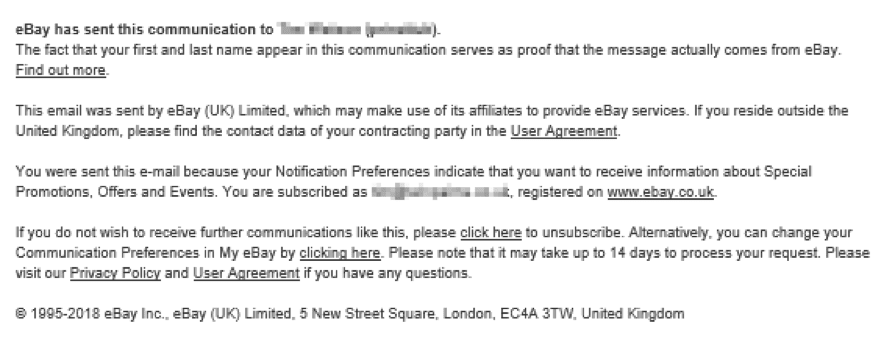
Fish through that! You can understand the customer complaint it’s just too hard to unsubscribe.
Contrast it with these two examples. The first from RateSetter and the second from Norwegian Air Shuttle.
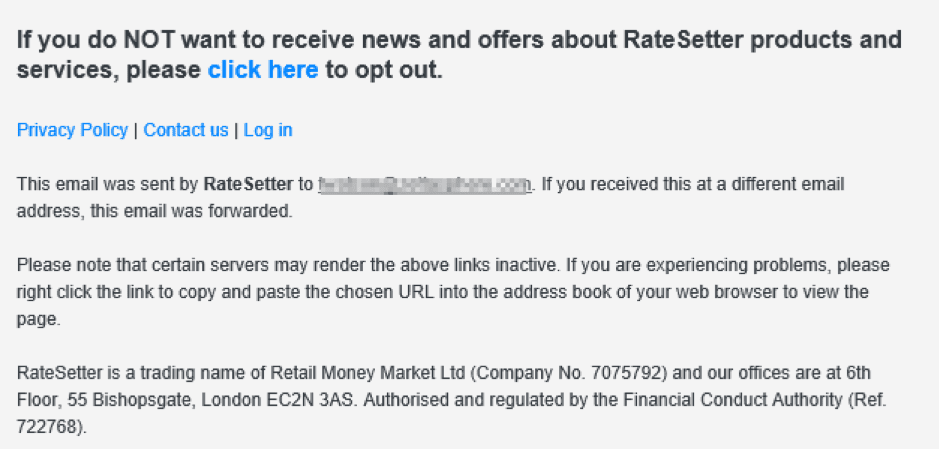
Norwegian Air Shuttle footer.
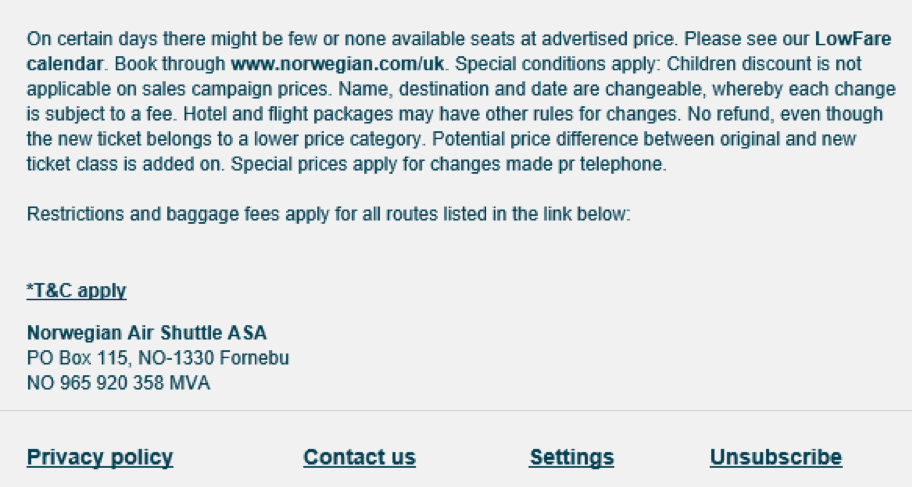
I’m sure you spotted the unsubscribe link much faster in the second two examples. The RateSetter footer not only used bold but kept the same font size as used in the email body.
The lesson here is be customer centric and avoid putting frustrating hurdles in the way of the unsubscribe. This means following these key points:
- Don’t bury the unsubscribe link in a dozen lines of footer copy
- Use an easy to read font size and colour
- Use language to build more trust around unsubscribe
- Provide a facility on your website for people to unsubscribe, such as within their account
- Repeat the unsubscribe at the top of your email – particularly on lifecycle campaigns to lapsing and lapsed.
Could it be better still? Use a button. I’ve never seen a footer with an unsubscribe button (tell me if you have). On the strength of the survey findings, it makes sense to try it - people look for buttons, it’s the reason marketers use buttons for key calls to action.
Avoiding irrelevance
Better still is to avoid someone going cold in the first place. Improving relevancy is the golden ticket. However, many brands just can’t be interesting to their customers 365 days a year.
When travelling I sometimes use HolidayExtras for car parking. HolidayExtras can try as hard as they like, if I’ve no travel plans they can’t be relevant.
Enter the win-back campaign.
When list quality issues are growing and deliverability is threatened, the win-back campaign is there to bring someone back as a customer, or at least confirm that they still wish to be on your list.
Win-back helps separate the emotionally engaged, who should be kept on the list, from the emotionally unengaged who may be removed to improve reputation.
Targeting the people who have stopped reading your emails, this is a typical win-back campaign:
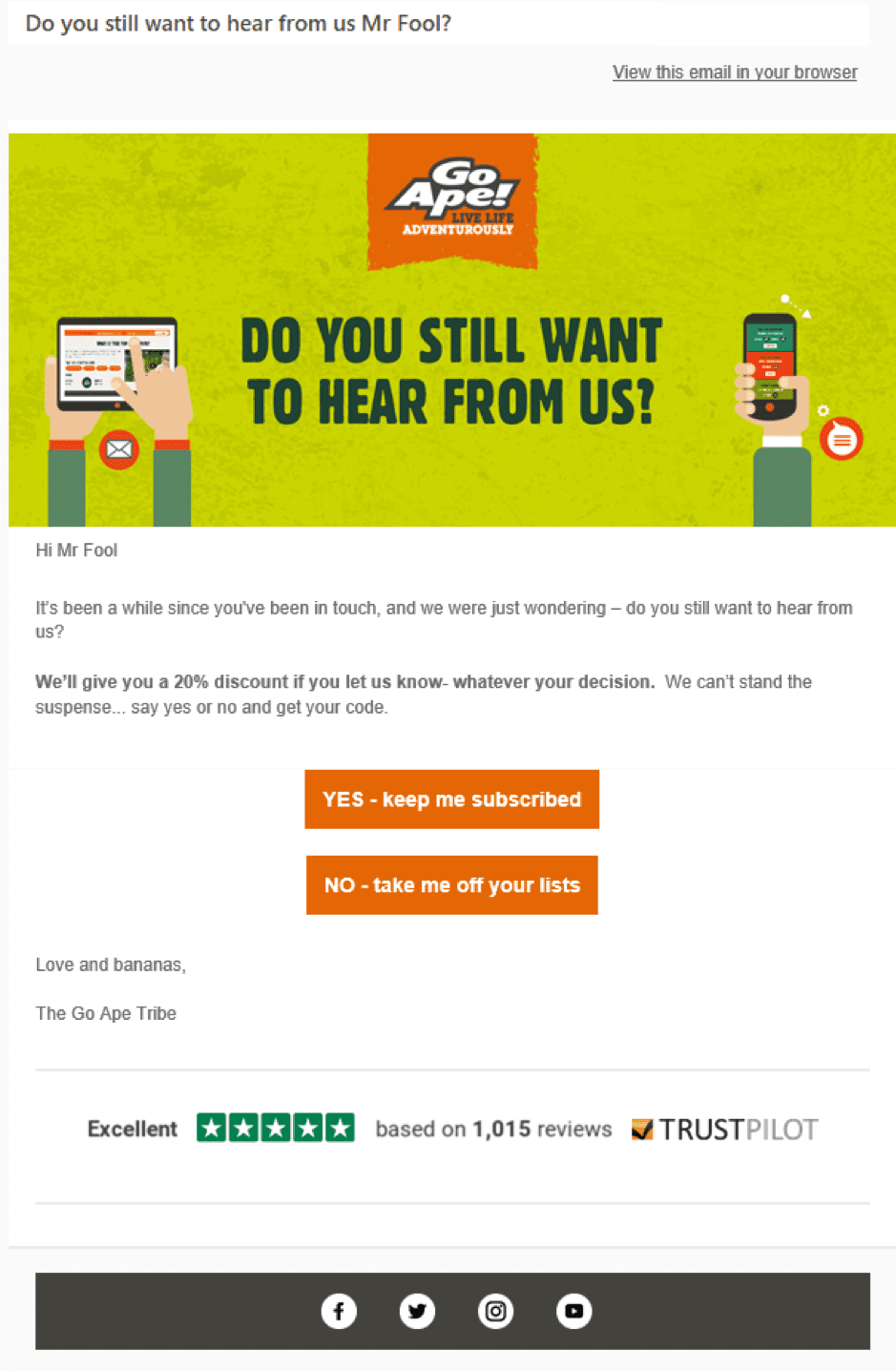
[Editorial note: GoApe aren’t being rude with the greeting ‘Mr Fool’, the last name for this person was Fool, making the personalised greeting Mr Fool]
After several attempts to get the customer to decide and still getting absolutely no response, you can then drop the frequency or remove the contact entirely. But let me stress, only do this if you have a reputation issue.
Frame the Win-back
Most win-back campaigns ask whether you still want emails or not.
Given the Email Addition research findings, is that the right question? The emotionally engaged are not unsubscribing because they think they will shop again, as soon as they need the brand.
Rather than focus on being a subscriber perhaps win-back campaigns should focus on being a customer. Ask the question “Is it possible you’ll shop with us again?” and offer answers:
- No, never, I have no use for your offers.
- Yes, it’s possible, keep me updated with offers.
This frames the question to think not about the email and inbox but the relationship with the brand.
More from Email Addiction
The consumer behaviour with unsubscribe was just one finding from the Email Addiction report. More include:
- Most common times when email is checked – spoiler – it’s all the time
- Over 50% of unengaged aren’t at all unengaged
- The innovations consumers would find valuable for email content
It’s a free report with no barrier page – get the consumer insight here.



